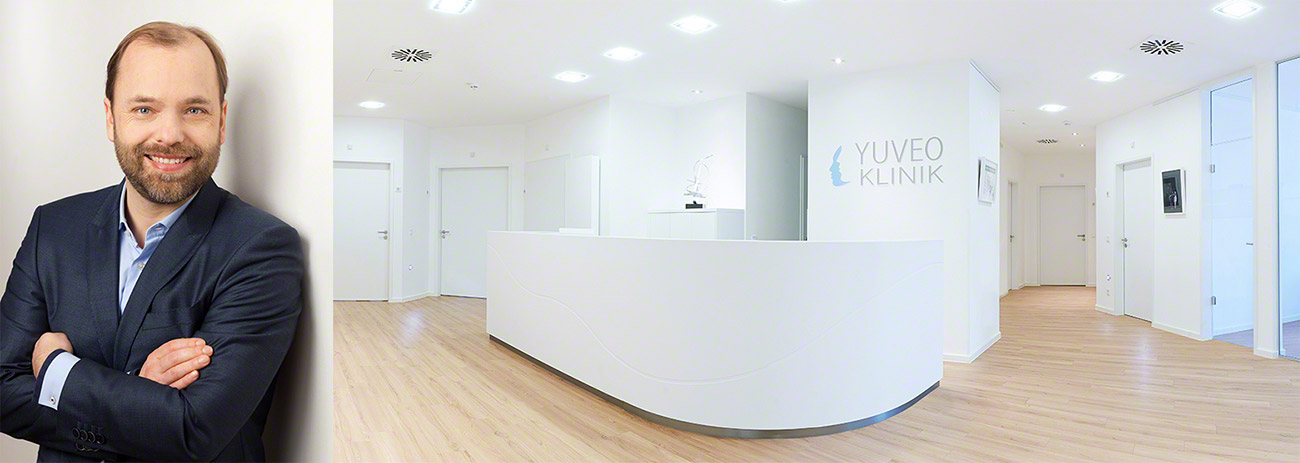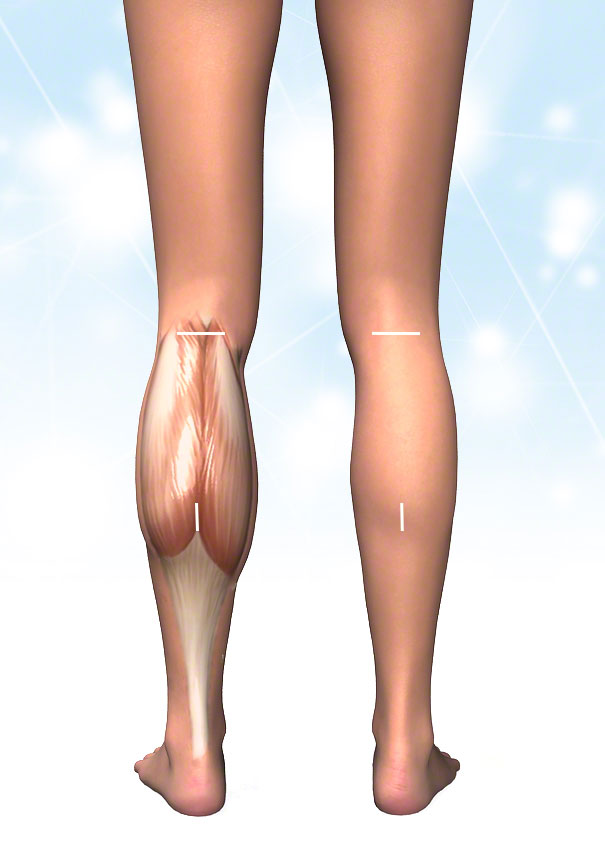Calf Reduction Surgery Germany
Operation or Botulinumtoxin?
Calf reduction has a subordinate role in plastic surgery, particularly in com parison with breast augmentation, breast reduction, abdominoplasty (tummy tuck), etc. However, there are many people (mostly women) who, due to their large calves, suffer psychological strain that is at least as intense as that of women who undergo breast augmentation because their breasts are too small, or women who decide on breast reduction surgery due to overly large breasts. This article should serve as information on the options available to you. In the end, whether you undergo calf reduction, and which method you decide on, depends on the subjective amount of psychological strain you are experiencing.
On this website Dr. Schumann (Board certified Plastic Surgeon from Germany) describes multiple ways of reducing the size of the calfs.
The very first thing is to decide whether the large calves are caused by fat deposits or by a muscular hypertrophy of the mauscles. Sometimes both fat and muscle are responsible for the dissatisfaction.

Dr. Schumann, Rene is Specialist in Plastic Surgery and Board certified Plastic and Aesthetic Surgeon. He is owner of YUVEO KLINIK in Germany.
What are the indications for calf reduction?
The choice of calf reduction technique depends on what caused the calf to become too robust. Often bulky calves (also known as “radish calves” or “radish legs”) are caused by simple accumulation of fatty tissue; in this case, liposuction is the best method for calf reduction.
In many cases, however, the calf muscle is also excessively thick. Liposuction has no effect in these cases. Extreme growth of the calf area can be observed in patients with muscular dystrophy. Muscular dystrophy is a hereditary disease which takes many different forms. Aesthetic concerns are not the main issue for patients with muscular dystrophy, making surgical calf reduction pointless.
Internal factors that create ‘fat calves’, such as water retention (edema) or lymphostasis (lymphedema), also require treatment for the cause of the problem, not cosmetic surgery.
More Topics
on our German main page
Gastrocnemius Resection
If skin quality is good, then we only need to make a 5cm incision across the hollow of the knee and an additional incision, approx. 2,5cm long, running vertical from the original incision in the middle of the lower leg (see image). The gastrocnemius muscle can be mobilized without a problem using these two openings.
You will find more information below ↓.
Botulinum toxin
We should also mention the Botox® (Botulinum toxin A) calf reduction method (8). Botox is a neurotoxin which causes myoparesis (slight muscular paralysis). Botulinum toxin is currently a standard treatment for mimetic wrinkles. It also has other uses, however – including calf reduction.
Selective Neurectomy
A selective neurectomy (denervation, nerve transection) is the separation of the nerve trunk which innervates the gastrocnemius muscle. If your calf consists mainly of fat then a calf liposuction will be the solution. After the neurectomy, the muscle atrophies, reducing the muscle’s volume. This procedure is a partial muscle reduction.
Radio frequency
Radio frequency calf reduction refers to obliteration of the muscle through several small skin punctures using electricity and heat. The procedure can be performed to varying degrees of intensity, but usually requires general anesthetic.
Liposuction
Calf surgery using Liposuction is an excellent treatment option in the event that the increase in size is caused by accumulation of fatty tissue.
Abstaining from exercise
Calf reduction can be achieved by abstaining from exercise. If the calves are perceived as too large due to intense physical activity, the enlargement can be reduced by avoiding certain exercises and types of training. Exercises which build up calf muscle should be avoided, in particular standing on your toes with and without weights, climbing stairs, hiking, and sprinting.
If you have some questions or if you would like to make a consultation, then please call
0049(0)211-2479040
or use our
Calf reduction through muscle surgery.
Image: The picture shows calf hypertrophy, and includes the gastrocnemius muscle. Right: reduced calf. The white lines portray the incisions necessary for completing the calf reduction and the resulting position of the scars.
If overly robust musculature (calf hypertrophy) is causing the increase in calf size, then the only way to achieve significant calf reduction is to remove a part of the calf muscle. Patients who decide to undergo this operation generally suffer from intense psychological strain. Men do not wear short pants, women do not wear short skirts, and they generally avoid locations such as swimming pools or the beach. Sometimes sufferers find it impossible to find regular boots or ski boots that fit.
We explain in the next section how it is possible to remove part of the muscle without limiting it’s function:
Calf Muscles
The actual calf muscle, located on the achilles tendon, is the triceps surae muscle (three headed calf muscle). This muscle is made up of the soleus muscle and the two headed gastrocnemius muscle. The former is essential for the function of the calf. The latter is an accessory muscle, whose loss does not lead to any change in function. The function of the muscle is simply assumed by other muscles (1,2). This is why the gastrocnemius muscle is frequently used in plastic surgery as a muscle flap to fix defects in the knee region.
History of Muscle Removal
Although surgically reducing the gastrocnemius muscle to achieve calf reduction is currently much more common in Asia than in Europe or on the American continent, the procedure originated in Germany. The first person to describe the technique was the German Plastic Sureon Prof. Gottfried Lemperle (5), who published a paper on the subject in 1998.
Patients who were supplied with a gastrocnemius muscle flap (both heads) to repair knee defects showed no long term mechanical damage to their calf function. In light of this information, 15 patients with muscular calf hypertrophy underwent calf reduction surgery involving complete removal of the gastrocnemius muscle. Two patients experienced temporary numbness at the outer edge of their foot due to a disturbance of a nerve serving this area (the sural nerve). This paresthesia disappeared completely, however. Every patient was satisfied with the results. None of the patients complained about loss of function. Every patient was able to participate in physical activities.
How does calf reduction by removing the gastrocnemius muscle work?
This is the most effective calf reduction method. The procedure can take place with the patient under general anesthetic or using an epidural.
If skin quality is good, then we only need to make a 5cm incision across the hollow of the knee and an additional incision, approx. 5cm long, running vertical from the original incision in the middle of the lower leg (see image). The gastrocnemius muscle can be mobilized without a problem using these two openings. It’s neurovascular bundle is located in the hollow of the knee; the surgeon cuts through it. The bundle is detached and removed at it’s origin and base. The knee hollow’s vessel and nerve structures sit deeper in the body and are not affected. Once a drain has been inserted (this is not always necessary) the wound is sutured in several layers. Effect: depending on the preoperative diagnosis, this type of calf reduction can reduce the circumference of the calf by somewhere between 5 and 7cm.
Advantages:
- The effectiveness of the calf reduction is maximized, because the hypertrophied muscle tissue is removed.
Disadvantages:
- More scars
- Increased short term loss of strength.
- Healthy muscle tissue is removed.
- The inner contour in the upper section of the calf can look a little unnatural, particularly for calves with very little fatty tissue.
Partial removal:
You can also have only part of the muscle described removed (6). For example, the surgeon can simply remove the inner muscle belly of the gastrocnemius muscle only. The technique is similar to that described above. This method does not prevent scars forming, as the muscle belly must be detached at the hollow of the knee and on the achilles
tendon.
What has to be watched for in post-operative care?
- The legs are bandaged after the operation, or a surgical stocking is worn – for three months!
- Depending on the degree of immobilization, heparin may be administered as a thrombosis prophylaxis
- Inpatient care is advisable for at least 24 hours after the operation
- Crutches provide safety and security for the first 2-3 days after the operation
- Physical reserve and elevation of the legs is recommended, particularly in the first two weeks after calf reduction
- The patient should abstain from sport for approx. 6 weeks
- Calves are fully functional after just a few weeks
- It can take more than 6 months for the calf muscles to regain their full strength
What is an endoscopic partial removal of the muscle?
The most common calf reduction method in Asia, particularly in Korea, is endoscopic calf reduction. Using this method one (for one muscle head) or two (for both muscle heads) approx. 2cm incisions are made in the hollow of the knee to reduce the size of the gastrocnemius muscle. This means that only part of the muscle is removed. The muscle is thinned using an electrocautery pencil (a scalpel which cuts using electricity and heat). The natural shape of the calf is thus largely maintained.
Advantages:
- Small incisions in the skin
- It is possible to shape the calves individually.
- Short term loss of strength is minimal.
Disadvantages:
- Healthy muscle tissue is removed.
- The calf’s circumference is not reduced as much as with complete muscle removal.
- If the surgeon is unable to shape the area cut out of the muscle smoothly then there could be visible irregular contours.
After care:
The after care for this type of calf reduction is similar to that listed in the previous section. However, in addition to those measures, the patient must perform intensive stretches multiple times a day for several months to prevent significant shrinking of the scar.
Additional Methods of calf reduction surgery.
Some studies, predominantly from Asia, have shown success in calf reduction by separating the gastrocnemius muscle’s nerve branch (neurectomy) (3,7) and obliteration of the muscle using radio frequency (4). In addition, the calf muscle can also be paralyzed using Botox ®.
Bibliography:
Pubmed:
- The Gastrocnemius muscle as a free-flap donor site. – Potparic, Colen, Sucur, Carwell, Carraway – Plast. Reconstr. Surg. 95:1245 (1995)
- Subtotal resection of Gastrocnemius muscles for hypertrophic muscular calves in Asians. – Lee JT, Wang CH, Cheng LF, Lin CM, Huang CC, Chien SH. – Plast Reconstr Surg. 2006 Nov;118(6):1472-83.
- The anatomic study and clinical observation of the neurectomy of the nerve to the medial Gastrocnemius muscle for calf reduction – Liu DL, Li XI, Shan L, Li Q, Yuan JL, Yuan Q. – Zhonghua Zheng Xing Wai Ke Za Zhi. 2007 Mar;23(2):125-7. Chinese.
- Radiofrequency volume reduction of Gastrocnemius muscle hypertrophy for cosmetic purposes. – Park YJ, Jo YW, Bang SI, Kim HJ, Lim SY, Mun GH, Hyon WS, Oh KS. – Aesthetic Plast Surg. 2007 Jan-Feb;31(1):53-61.
- The resection of gastrocnemius muscles in aesthetically disturbing calf hypertrophy. – Lemperle G, Exner K. – Plast Reconstr Surg. 1998 Nov;102(6):2230-6.
- Leg re-contouring by using a new technique of partially removing Gastrocnemius – Qin RS, Wang X, Chen YZ, Xie HB, Zhu L, Li B, Ma YG, You WT, Li D, Li JN. – Zhonghua Zheng Xing Wai Ke Za Zhi. 2003 Mar;19(2):85-7. Chinese.
- Selective neurectomy of the Gastrocnemius and soleus muscles for calf hypertrophy: an anatomical study and 700 clinical cases. – Tsai FC, Mardini S, Fong TH, Kang JH, Chou CM. – Plast Reconstr Surg. 2008 Jul;122(1):178-87.
- Botulinum toxin a for aesthetic contouring of enlarged medial gastrocnemius muscle. – Lee HJ, Lee DW, Park YH, Cha MK, Kim HS, Ha SJ. – Dermatol Surg. 2004 Jun;30(6):867-71; discussion 871.
More topics
on our german main page yuveo.de


